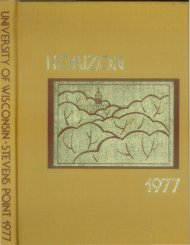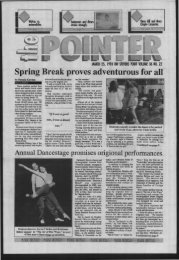Reproduction and Age and Growth in Wisconsin Darters
Reproduction and Age and Growth in Wisconsin Darters
Reproduction and Age and Growth in Wisconsin Darters
You also want an ePaper? Increase the reach of your titles
YUMPU automatically turns print PDFs into web optimized ePapers that Google loves.
Etheostoma microperca. Least Darter.<br />
The spawn<strong>in</strong>g period <strong>in</strong> Wiscons<strong>in</strong> occurs from mid or late April to early July. In the Ann Arbor (Michigan)<br />
region, spawn<strong>in</strong>g occurred from the middle of April to the fIrst or middle of June (W<strong>in</strong>n 1958b). In the Bell<br />
Branch of the River Rouge, Michigan, spawn<strong>in</strong>g occurred on May 5 <strong>in</strong> 0.15 m of water, with temperatures rang<strong>in</strong>g<br />
from 13.5 0 C <strong>in</strong> the morn<strong>in</strong>g to 15.5 0 C <strong>in</strong> the afternoon (Petravicz 1936). The pH.of the water was 7.9-8.0. He<br />
also noted a spawn<strong>in</strong>g on April 26 at a water temperature of 12 0 C. In the Gasconade River, Kansas, spawn<strong>in</strong>g<br />
occ4ued on April 5 when water temperatures were 12.8 0 C (Cross 1967). .<br />
fiJ:1f Wiscons<strong>in</strong>, one age I female collected <strong>in</strong> May had 146 ova 1 mm <strong>in</strong> diameter. Two age I females <strong>in</strong> June<br />
had 150 <strong>and</strong> 194 mature ova.<br />
In Wiscons<strong>in</strong> specimens, the ovaries were best developed dur<strong>in</strong>g May (I9% of the body weight) <strong>and</strong> rema<strong>in</strong>ed<br />
high through July (12.92% of the body weight) (Figure 9). The ovaries <strong>in</strong> September comprised only<br />
1.89% of the body weight. The testes were largest <strong>in</strong> June <strong>and</strong> July, compris<strong>in</strong>g 1.21 <strong>and</strong> 2.78% of the body<br />
weight. They dropped to 0.4% of the body weight by September.<br />
<strong>Age</strong> <strong>and</strong> <strong>Growth</strong>:<br />
A total of 254 specimens from Wiscons<strong>in</strong> were exam<strong>in</strong>ed for age <strong>and</strong> growth. Of these, 243 came from central<br />
Wiscons<strong>in</strong> <strong>and</strong> 1 I from the southern region (Table 7). The central Wiscons<strong>in</strong> fIsh grew slightly faster than<br />
those from the southern region of the state (Figure 10). In central Wiscons<strong>in</strong> age 0 fIsh <strong>in</strong> September were 25-36<br />
mm TL <strong>and</strong> <strong>in</strong> southern Wiscons<strong>in</strong> <strong>in</strong> August were 24-26 mm TL.<br />
<strong>Age</strong> I fIsh <strong>in</strong> central Wiscons<strong>in</strong> were 35 (2841) mm TL. The mean calculated TL at the first annulus was<br />
31. I 8 mm. In southern Wiscons<strong>in</strong>, age I fish were 32.5 (32-33) mm TL, <strong>and</strong> the mean calculated tL at the first<br />
annulus was 29.75 mm. In Ohio, Trautman (1957) found adults rang<strong>in</strong>g from 25-37 mm <strong>in</strong> length. The largest<br />
specimen from Ohio was 45 mm <strong>in</strong> length.<br />
Table 7. <strong>Age</strong> <strong>and</strong> growth of Least <strong>Darters</strong> <strong>in</strong> Wiscons<strong>in</strong>.<br />
Central Wiscons<strong>in</strong><br />
<strong>Age</strong> Class No. ofFish Total Length <strong>in</strong> mm<br />
Mean Range<br />
I<br />
II<br />
38<br />
1<br />
Gr<strong>and</strong> Ave.<br />
Increments of<br />
<strong>Growth</strong><br />
No. ofFish 39<br />
35.00<br />
38.00<br />
(2841)<br />
(38)<br />
Southern Wiscons<strong>in</strong><br />
Mean Calculated Total Length(mm) at Annulus<br />
1 2<br />
3 I .21<br />
30.00 38.00<br />
31.18<br />
3U8<br />
39<br />
38.00<br />
<strong>Age</strong> Class No. ofFish Total Length <strong>in</strong> mm Mean Calculated Total Length (mm) at Annulus<br />
Mean Range 1 2<br />
6.82<br />
1<br />
2 32.50 (32-33) 29.00<br />
II 2 35.00 (35) 30.50 35.00<br />
. Gr<strong>and</strong> Ave. 29.75 35.00<br />
Increments of<br />
<strong>Growth</strong> 29.75 5.25<br />
No. of Fish 4 4 2<br />
18<br />
f"<br />
,<br />
i<br />
I















